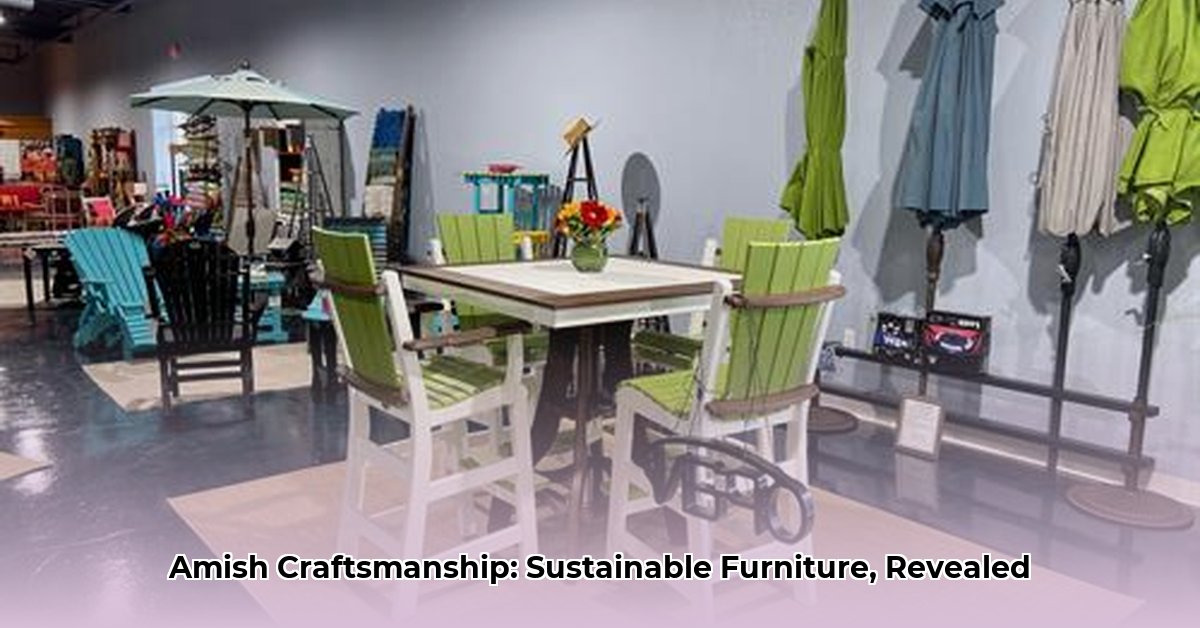
Amish Craftsmen Guild Cedarburg: A Case Study in Sustainable Furniture Making
Nestled in the charming town of Cedarburg, Wisconsin, the Amish Craftsmen Guild II represents a unique approach to furniture making—one deeply rooted in both traditional craftsmanship and modern sustainability. They're not just crafting beautiful, durable outdoor furniture; they're building a business model that prioritizes environmental responsibility and economic viability. Their journey, however, hasn't been without challenges. This case study explores their innovative use of polylumber, the obstacles they've overcome, and the exciting possibilities for the future of sustainable furniture.
The Guild's Innovative Approach: Polylumber and Timeless Craftsmanship
The Amish Craftsmen Guild II distinguishes itself through its innovative use of polylumber (a high-strength composite material made from recycled plastics) as an alternative to traditional hardwoods. This decision reflects a profound commitment to sustainability. Instead of depleting forests, they are repurposing waste materials, reducing environmental impact. The process is a remarkable blend of time-honored Amish craftsmanship and modern, eco-conscious materials. Highly skilled artisans meticulously shape and assemble each piece, ensuring heirloom-quality furniture built to last for generations. The result? Furniture that is not only aesthetically pleasing but also durable and environmentally responsible. "Our commitment to sustainability isn't merely a marketing ploy; it's integral to our values," explains Elias Miller, Guild Master Craftsman.
Isn't it remarkable how a commitment to sustainability can enhance the quality and durability of the product? This question highlights the unexpected synergies achievable through eco-conscious design.
Challenges and Opportunities: Navigating the Path to Sustainable Growth
The Guild's journey hasn't been without its hurdles. Securing a consistent supply of recycled plastics for polylumber production presents an ongoing challenge. Fluctuations in material availability can disrupt production schedules. Expanding beyond their local customer base requires a strategic approach to maintain their artisanal production methods. However, opportunities abound. Strengthening their online presence, forging strategic partnerships, and investing in research and development to refine polylumber production techniques all offer avenues for growth. "The challenge lies in balancing our commitment to quality and sustainability with the need to scale our business responsibly," states Sarah Yoder, Guild Marketing Director.
How can the Guild leverage the potential of e-commerce to maintain its commitment to artisanal production while expanding its reach? This question spotlights the intersection of traditional craftsmanship and modern technology.
Case Study Analysis: Strengths, Weaknesses, Opportunities, and Threats
The Guild's success can be analyzed through a SWOT framework:
Strengths: Exceptional craftsmanship, unique polylumber material, strong local reputation, dedication to sustainability.
Weaknesses: Limited scalability, reliance on local material sourcing, restricted market reach, potential supply chain vulnerabilities.
Opportunities: Enhanced online presence, strategic partnerships, technological advancements in polylumber production, expansion into new markets.
Threats: Fluctuations in material costs, increased competition from mass-produced furniture, changing consumer preferences, potential regulatory changes.
Conclusion and Call to Action: A Sustainable Future, One Piece at a Time
The Amish Craftsmen Guild II provides a compelling case study demonstrating successful sustainable business practices. Their commitment to environmental responsibility, coupled with their dedication to exceptional craftsmanship, makes them a model for other businesses. Their story highlights the potential of combining traditional values with innovative solutions. The future of sustainable furniture making rests on a collaborative effort between consumers, local governments, and environmental organizations.
For Consumers: Supporting local, sustainable businesses; demanding transparency; choosing durable, high-quality furniture.
For Local Government: Offering incentives to sustainable businesses; developing infrastructure for material sourcing; supporting research.
For Environmental Groups: Advocating for policies promoting recycled materials; educating consumers; supporting research.
The Amish Craftsmen Guild II's innovative approach to furniture making underscores the crucial integration of sustainability and quality in the furniture industry. Their dedication serves as a call to action for all stakeholders in creating a more environmentally responsible future, one handcrafted piece of furniture at a time.